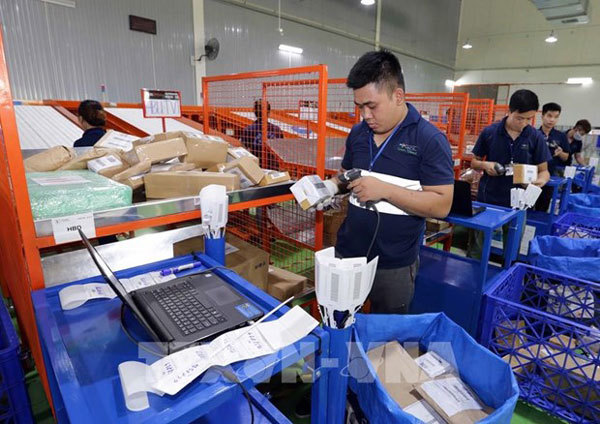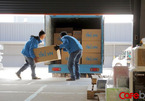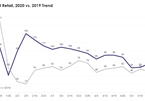 |
| Staff at Lazada e-commerce platform. (Illustrative image. – Photo: VNA) |
She’s a little concerned, though, with how much cardboard and plastic her shopping comes wrapped in.
“I was already shopping online quite often before the pandemic hit, because I liked not having to go out somewhere, making quick price comparisons before buying, and generally saving time,” she explained.
“I began to work from home during the social distancing period earlier this year, and found I was shopping online more, buying food, clothing, and cosmetics.
“As soon as I became a frequent online shopper it was noticeable how many boxes and plastic bags I quickly acquired. If every person who shops online has as much cardboard and plastic as I do, and if everything is simply thrown away, there must be a serious impact on the environment.”
The already-growing popularity of e-commerce and then the current COVID-19 pandemic resulted in a sharp increase in the number of online shoppers around the world.
According to a survey and report on consumption trends in 2019 and the “new normal” following the pandemic being largely brought under control, released by the Business Association of High-Quality Vietnamese Products, about 82 per cent of respondents shopped online during social distancing and 92 per cent of them will continue to do so into the future.
In some countries, like South Korea, online shopping reached record after record as the number of coronavirus cases continued to rise. It is estimated that as much as 14.38 trillion won (US$12.4 billion) was spent on online shopping in August, a rise of 27.5 per cent compared to a year ago.
Such figures may be pleasing to businesses but would concern environmentalists.
According to a report from Greenpeace, 9.4 million tonnes of materials were used to wrap goods bought online in 2018 and this will rise to 41.3 million tonnes in 2025 if nothing is done.
Figures from Fastmarkets.com late last year revealed that online shopping consumes seven-times more paper and cardboard than bricks-and-mortar shopping.
In North America in particular, e-commerce used 1.3 million tonnes of paper and cardboard in 2018. It’s been estimated that the 165 billion packages delivered throughout the US each year are wrapped in what used to be more than a billion trees.
While it’s understandable that both seller and buyer want the goods to arrive intact, they are often wrapped in too many layers that add no extra protection beyond a certain point.
“I bought a bottle of hand sanitiser on the internet and it was wrapped in four layers - two of bubble wrap, one of cardboard, and one of plastic tape,” Phuong said.
“I appreciate the thoughtfulness behind wrapping things that way, but it’s a huge waste of materials.”
Unlike shopping in supermarkets, where people buy many things at one time and carry them home in a few plastic bags, shopping in cyberspace often means one plastic bag or box for every item bought.
Most of these bags and boxes ultimately end up in garbage dumps, adding to the amount of plastic waste already threatening the Earth’s well-being.
At the same time, more online purchases mean more delivery vans or bikes on the streets, leading to traffic jams, noise pollution, and a larger carbon footprint.
Many deliveries are unsuccessful at first attempt, necessitating one return trip at the very least. Carbon emissions also rise when customers seek to return a purchase, adding yet another trip out into the traffic.
But there is some good news, thankfully. More and more online retailers have been looking at changes they could make to benefit both customers and the environment.
For example, Amazon and many online stores on Shopee have gradually switched to recyclable containers instead of cardboard boxes.
“We have also encouraged customers to select slow delivery, which causes less environmental damage than speedy delivery,” said Tran Huyen Anh, the owner of online clothing store Sâu Kiu vnxk.
Another way to reduce waste is to encourage retailers to retain the original packaging the goods arrived from the manufacturer in, rather than adding extra layers before shipping them out.
For consumers, environmentalists suggest they change their shopping habits, reducing visits to online markets and doing most of their shopping in person.
They can also make both in-store and online shopping “greener” with three simple measures: planning to buy many items at the one time, avoiding speedy shipping, even when it’s free, and, ultimately, shopping less.
“I’ve sent messages to a lot of online shops asking them to cut down on their packaging as much as possible,” said Phuong.
“Now the pandemic is under control, I prefer to go out and buy things sitting on supermarket shelves.” VNS
Luong Thu Huong

Covid-19 pandemic gives big push to online shopping
Vietnam’s e-commerce saw a 30 percent growth rate from 2016 to 2020, according to the Ministry of Investment and Planning. The country aims to have 55 percent of population shopping online by 2025.

Vietnamese consumers turn to online shopping amidst COVID-19 pandemic
Criteo recently unveiled the results of its research analysing the impact of COVID-19 pandemic on the e-commerce landscape.